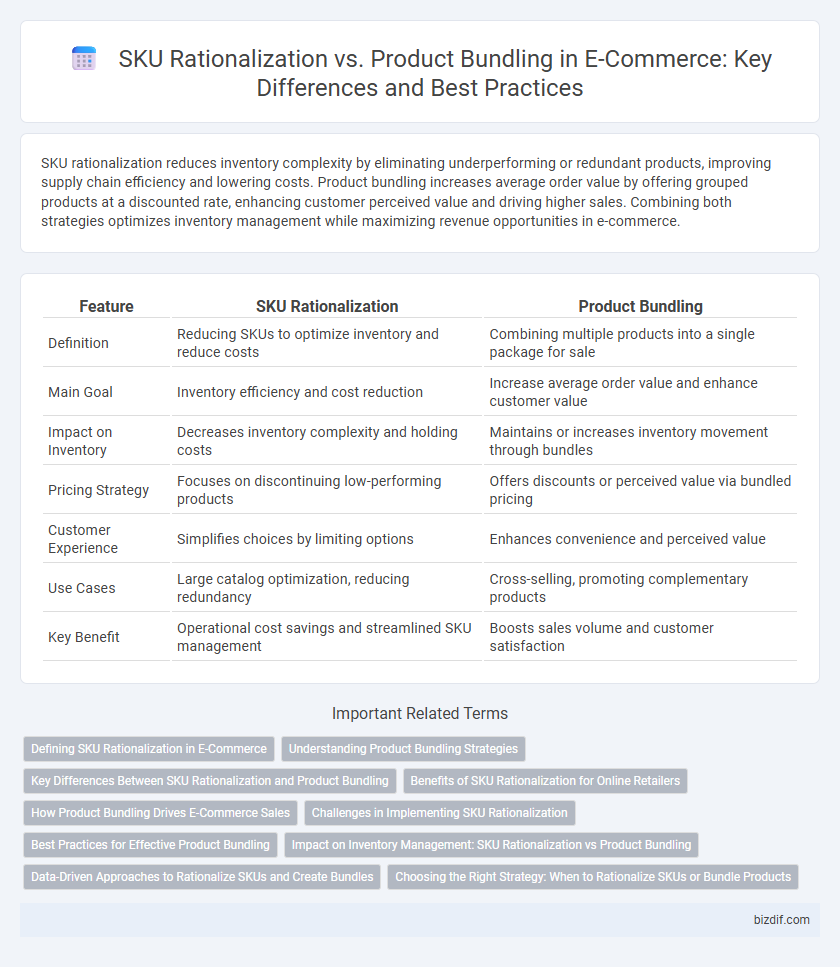SKU rationalization reduces inventory complexity by eliminating underperforming or redundant products, improving supply chain efficiency and lowering costs. Product bundling increases average order value by offering grouped products at a discounted rate, enhancing customer perceived value and driving higher sales. Combining both strategies optimizes inventory management while maximizing revenue opportunities in e-commerce.
Table of Comparison
| Feature | SKU Rationalization | Product Bundling |
|---|---|---|
| Definition | Reducing SKUs to optimize inventory and reduce costs | Combining multiple products into a single package for sale |
| Main Goal | Inventory efficiency and cost reduction | Increase average order value and enhance customer value |
| Impact on Inventory | Decreases inventory complexity and holding costs | Maintains or increases inventory movement through bundles |
| Pricing Strategy | Focuses on discontinuing low-performing products | Offers discounts or perceived value via bundled pricing |
| Customer Experience | Simplifies choices by limiting options | Enhances convenience and perceived value |
| Use Cases | Large catalog optimization, reducing redundancy | Cross-selling, promoting complementary products |
| Key Benefit | Operational cost savings and streamlined SKU management | Boosts sales volume and customer satisfaction |
Defining SKU Rationalization in E-Commerce
SKU rationalization in e-commerce involves analyzing and optimizing the inventory by evaluating product SKUs to reduce redundancy and improve profitability. This process focuses on identifying underperforming or obsolete SKUs to streamline the product catalog, enhance inventory turnover, and minimize carrying costs. Effective SKU rationalization ensures a more efficient supply chain and better alignment with customer demand, boosting overall operational efficiency.
Understanding Product Bundling Strategies
Product bundling strategies in e-commerce involve grouping complementary products to enhance customer value and boost average order value, optimizing inventory turnover and reducing marketing costs. SKU rationalization focuses on analyzing product performance data to eliminate underperforming or redundant stock-keeping units, streamlining the product catalog for operational efficiency. Combining product bundling with SKU rationalization enables retailers to maximize sales opportunities while maintaining a lean and profitable inventory.
Key Differences Between SKU Rationalization and Product Bundling
SKU rationalization involves analyzing and reducing the number of product SKUs to optimize inventory management and improve sales efficiency, whereas product bundling combines multiple products into a single package to increase average order value and enhance customer appeal. SKU rationalization focuses on minimizing redundant or slow-moving stock to cut costs, while product bundling aims to maximize revenue by offering complementary items together. The key difference lies in SKU rationalization's goal to streamline the product assortment, contrasting with product bundling's strategy to boost sales through combined offerings.
Benefits of SKU Rationalization for Online Retailers
SKU rationalization streamlines inventory management by eliminating low-performing or redundant products, reducing storage costs and improving stock turnover rates. This approach enhances the customer experience through clearer product offerings and faster fulfillment times, leading to increased satisfaction and repeat purchases. By focusing on a more profitable and manageable inventory, online retailers can boost operational efficiency and optimize supply chain performance.
How Product Bundling Drives E-Commerce Sales
Product bundling increases e-commerce sales by offering curated product combinations that enhance customer value and encourage higher average order quantities. Bundles reduce choice overload, streamline purchasing decisions, and promote the discovery of new or complementary products, leading to improved conversion rates and customer satisfaction. Strategic product bundling leverages data analytics to tailor offers that meet consumer preferences, maximizing revenue and inventory turnover.
Challenges in Implementing SKU Rationalization
Implementing SKU rationalization in e-commerce presents challenges such as accurately analyzing vast product data to identify underperforming SKUs without disrupting customer preferences. Balancing inventory reduction while maintaining variety and avoiding stockouts requires sophisticated forecasting and demand planning tools. Integrating cross-departmental collaboration between merchandising, marketing, and supply chain teams is essential to optimize SKU assortment and improve overall profitability.
Best Practices for Effective Product Bundling
Effective product bundling in e-commerce maximizes average order value by strategically grouping complementary SKUs based on customer purchase behavior and inventory data. Utilizing sales analytics and market segmentation enhances bundle relevance, driving both cross-selling opportunities and inventory turnover. Implementing dynamic pricing models and clear product descriptions further optimizes conversion rates and customer satisfaction.
Impact on Inventory Management: SKU Rationalization vs Product Bundling
SKU rationalization streamlines inventory management by reducing the number of stock-keeping units, leading to lower holding costs and simplified supply chain operations. Product bundling can increase average order value but may complicate inventory tracking due to the need to manage component stock levels and demand variability. Effective balance between SKU rationalization and product bundling enhances inventory turnover and minimizes stockouts or overstock situations in e-commerce businesses.
Data-Driven Approaches to Rationalize SKUs and Create Bundles
Data-driven SKU rationalization leverages sales analytics, customer behavior, and inventory turnover rates to identify underperforming products and optimize the product assortment. Advanced algorithms analyze purchase patterns to create complementary product bundles that enhance customer value and increase average order value. Integrating machine learning models enables dynamic adjustments to SKUs and bundles based on real-time market trends and consumer demand.
Choosing the Right Strategy: When to Rationalize SKUs or Bundle Products
SKU rationalization is ideal when streamlining inventory to reduce carrying costs and eliminate low-performing products, enhancing operational efficiency. Product bundling works best for increasing average order value and promoting complementary items that drive customer satisfaction. Choosing the right strategy depends on analyzing sales data, customer preferences, and inventory turnover to align with business goals.
SKU Rationalization vs Product Bundling Infographic

 bizdif.com
bizdif.com